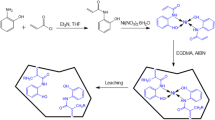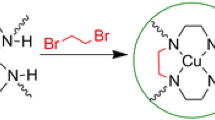Abstract
Nickel ion imprinted polymer (Ni-IIP) was prepared using microwave-assisted surface imprinting technique with Ni2+ as the template, salicylaldehyde-ethylenediamine Schiff base as functional monomers, ethylene glycol dimethacrylate as a crosslinking agent and alkylated silica gel as a carrier. Fourier transform infrared spectroscopy (FTIR) was used to characterize Ni-IIP, which confirmed the successful synthesis of the polymer. Scanning electron microscopy (SEM) was used to compare the surface morphology of Ni-IIP to non-imprinted polymer (NIP). The SEM analysis found that Ni-IIP had many holes on its surface and abundant spherule structures after elution, while NIP only had a few irregular holes on its surface. The adsorption performance of IIP was studied under different conditions, including pH, temperature, and initial concentration of Ni. The experimental results showed that the maximum adsorption capacity of IIP for Ni was 24.23 mg g–1 at pH 8, temperature of 30°C, adsorption time of 40 min, and initial concentration of Ni of 30 mg L–1. The pseudo-second-order kinetic equation could better describe the whole adsorption process, suggesting that chemical adsorption mainly controlled the adsorption process of nickel ions. The Langmuir adsorption isotherm model showed a high linear relationship, and the theoretical adsorption capacity was closer to the actual adsorption capacity, indicating that the adsorption of nickel ions by IIP and NIP occurred in a single layer. Selective experiments showed that IIP had specific selectivity for nickel ions compared with Cu2+, Zn2+, and Cd2+. The results obtained from the analysis of regeneration and practical application demonstrate the promising potential of the prepared Ni-IIP for the efficient removal of nickel pollutants from water sources. These findings provide a new approach to the removal of Ni from wastewater.
Access this article
We’re sorry, something doesn't seem to be working properly.
Please try refreshing the page. If that doesn't work, please contact support so we can address the problem.





Similar content being viewed by others
REFERENCES
Raval, N.P., Shah, P.U., and Shah, N.K., Adsorptive removal of nickel(II) ions from the aqueous environment—A review, J. Environ. Manage., 2016, vol. 179, pp. 1–20. https://doi.org/10.1016/j.jenvman.2016.04.045
Hao, J., Ren, J., Tao, L., Fang, H., Gao, S., and Chen, Yi., Pollution evaluation and sources identification of heavy metals in surface sediments from upstream of Yellow River, Pol. J. Environ. Stud., 2021, vol. 30, no. 2, pp. 1161–1169. https://doi.org/10.15244/pjoes/125485
El-Naggar, A., Ahmed, N., Mosa, A., Niazi N.K., Yousaf, B., Sharma, A., Sarkar, B., Cai, Y., and Chang, S.X., Nickel in soil and water: Sources, biogeochemistry, and remediation using biochar, J. Hazard. Mater., 2021, vol. 419, p. 126421. https://doi.org/10.1016/j.jhazmat.2021.126421
Ahmad, M.S.A. and Ashraf, M., Essential roles and hazardous effects of nickel in plants, Rev. Environ. Contam. Toxicol., 2011, vol. 214, pp. 125–167.
Lochynski, P., Wiercik, P., Charazinska, S., et al., Research on neutralization of wastewater from pickling and electropolishing processes, Arch. Environ. Prot., 2021, vol. 47, no. 4, pp. 18–29. https://doi.org/10.24425/aep.2021.139499
Duong, H.C., Pham, T.M., Luong, S.T., et al. A novel application of membrane distillation to facilitate nickel recovery from electroplating wastewater, Environ. Sci. Pollut. Res., 2019, vol. 26, no. 23, pp. 23407–23415. https://doi.org/10.1007/s11356-019-05626-9
Benalla, S., Bachiri, B., Touir, J., et al., Feasibility of electrodialysis in heavy metals removal from brassware wastewaters, Desalin. Water Treat., 2021, vol. 240, pp. 106–114. https://doi.org/10.5004/dwt.2021.27721
He, S.Y., Zhu, F., Li, L.W., et al., Box-Behnken design for the optimization of the removal of Cr(VI) in soil leachate using nZVI/Ni bimetallic particles, Soil Sediment Contam., 2018, vol. 27, no. 8, pp. 658–673. https://doi.org/10.1080/15320383.2018.1502744
Lee, L.Y., Morad, N., Ismail, N., et al., Selective separation of cadmium(II), copper(II) and nickel(II) ions from electroplating wastewater using dual flat sheet supported liquid membrane, Desalin. Water Treat., 2021, vol. 224, pp. 291–301. https://doi.org/10.5004/dwt.2021.27186
Cheng, Z., Xu, D.Y., Zhang, Q.Y., et al., Enhanced nickel removal and synchronous bioelectricity generation based on substrate types in microbial fuel cell coupled with constructed wetland: Performance and microbial response, Environ. Sci. Pollut. Res., 2023, vol. 30, pp. 19725–19736. https://doi.org/10.1007/s11356-022-23458-y
Rajendran, S., Priya, A.K., Kumar P.S., et al., A critical and recent developments on adsorption technique for removal of heavy metals from wastewater—A review, Chemosphere, 2022, vol. 303, p. 135146. https://doi.org/10.1016/j.chemosphere.2022.135146
El Ouardi, Y., Giove, A., Laatikainen, M., et al., Benefit of ion imprinting technique in solid-phase extraction of heavy metals, special focus on the last decade, J. Environ. Chem. Eng., 2021, vol. 9, no. 6, p. 106548. https://doi.org/10.1016/j.jece.2021.106548
Lazar, M.M., Ghiorghita, C.-A., Dragan, E.S., et al., Ion-imprinted polymeric materials for selective adsorption of heavy metal ions from aqueous solution, Molecules, 2023, vol. 28, no. 6, p. 2798. https://doi.org/10.3390/molecules28062798
Li, W.D., Li, Y., Cai, P.Y., et al., A novel ion-imprinted polymer based on the principle of ion exchange by bulk polymerization for specific recognition and adsorption of nitrate in polluted groundwater, J. Water Process Eng., 2023, vol. 51, p. 103375. https://doi.org/10.1016/j.jwpe.2022.103375
Jiang, Y., Tang, B.L., Zhao, P.F., et al., Synthesis of copper and lead ion imprinted polymer submicron spheres to remove Cu2+ and Pb2+, J. Inorg. Organomet. Polym. Mater., 2021, vol. 31, no. 12, pp. 4628–4636. https://doi.org/10.1007/s10904-021-02065-3
Xing, J.D., Li, N., Liang, Y.K., et al., Microwave-assisted synthesis of magnetic Pb(II)-imprinted-poly(schiff base-co-MAA) for selective recognition and extraction of Pb(II) from industrial wastewater, J. Dispersion Sci. Technol., 2023, vol. 44, no. 1, pp. 12–25. https://doi.org/10.1080/01932691.2021.1930033
Yuan, S.B., Ning, K.G., and He, Y.J., Removal of copper ions using poly (acrylic acid-co-acrylamide) hydrogel microspheres with controllable size prepared by W/O Pickering emulsions, Colloid Polym. Sci., 2020, vol. 298, no. 11, pp. 1465–1472. https://doi.org/10.1007/s00396-020-04715-3
Ma, R., Yang, Y.H., Zhang, X.N., et al., Preparation and optimization of diatom-based cadmium ion-imprinted materials, J. Mol. Struct., 2022, vol. 1251, p. 132044. https://doi.org/10.1016/j.molstruc.2021.132044
Kuang, Y., Chen, W., Chen, Z.H, et al., Highly-efficient selective recognition and rapid enrichment of chrysin by magnetic surface molecularly imprinted polymer, Food Chem., 2023, vol. 405, p. 134993. https://doi.org/10.1016/j.foodchem.2022.134993
Zhang, H., Ma, R., Yang, Y.H., et al., Study of ion-imprinted adsorbent materials on diatom-based Cr(VI) Surfaces, Mater. Lett., 2022, vol. 308., p. 131149. https://doi.org/10.1016/j.matlet.2021.131149
Bao, Y.M., Zhao, Y., Qin, G.J, et al., Histidine-mediated dendritic mesoporous magnetic ion-imprinted polymer toward effective and recoverable cadmium removal, Colloids Surf., A, 2023, vol. 656, p. 130365. https://doi.org/10.1016/j.colsurfa.2022.130365
Belkhir, K., Riquet, G., Becquart, F., Polymer processing under microwaves, Adv. Polym. Technol., 2022, vol. 2022, p. 3961233. https://doi.org/10.1155/2022/3961233
Chen, F.F., Wang, J.Y., Chen, H.R., et al., Microwave-assisted RAFT polymerization of well-constructed magnetic surface molecularly imprinted polymers for specific recognition of benzimidazole residues, Appl. Surf. Sci., 2018, vol. 435, pp. 247–255. https://doi.org/10.1016/j.apsusc.2017.11.061
Li, N., Lu, H.J., Liang, Y.K., et al., Microwave-assisted magnetic Cu(II)-imprinted-polymer based on double functional monomers for selective removal of Cu(II) from wastewater, J. Water Chem. Technol., 2022, vol. 44, no. 6, pp. 431–439. https://doi.org/10.3103/S1063455x2206008X
Yang, H., Hu, Y.L., Wang, X.Y., et al., Investigation on synthesis of ion-imprinted mesoporous adsorbents by using ultrasound- and microwave-assisted preparation and their dynamic adsorption properties on heavy metals, Environ. Sci. Pollut. Res., 2019, vol. 26, no. 11, pp. 10987–10999. https://doi.org/10.1007/s11356-019-04436-3
Funding
This article was supported by the National Natural Science Foundation of China (project no. 21276174) and the Natural Science Foundation of Shanxi province (project nos. 201801D121267 and 2013011040-1).
Author information
Authors and Affiliations
Corresponding author
Ethics declarations
The authors declare that they have no conflicts of interest.
About this article
Cite this article
Huishen Xu, Liang, Y. & Zhu, F. Efficient Removal of Nickel from Wastewater by Microwave-Assisted Synthesized Nickel Surface Ion Imprinted Polymer. J. Water Chem. Technol. 45, 533–543 (2023). https://doi.org/10.3103/S1063455X23060127
Received:
Revised:
Accepted:
Published:
Issue Date:
DOI: https://doi.org/10.3103/S1063455X23060127




